| Back to . . . .
 Curve Bank Home Curve Bank Home
NCB
Deposit
# 27
Tevian Dray
Department of Mathematics
Oregon State University
Corvallis, OR 97331
tevian@math.orst.edu
|

Coriolis Effects via "Earth Hockey"
Coriolis Acceleration: A Term from Physics
|
In this section . . .
An Application
of
Vector Calculus
|
For the student . . . .
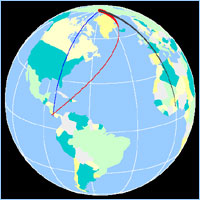 |
Dray has also provided
animations
of a map of the Earth using vaious rotations about a fixed point or
fixed
line. Please click on the map below. This animation
shows
how to generate any rotation by using two successive 180 degree
rotations
about different axes.
|
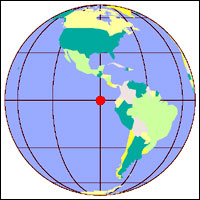 |
|
Background . . . .
Briefly, Coriolis acceleration is the apparent acceleration one sees when observing particle motion from a rotating, rather an an inertial, reference frame. For instance, the needle of a phonograph moves (nearly) in a straight line, yet traces a spiral on the rotating record. Coriolis acceleration is the apparent acceleration one sees when observing particle motion from a rotating, rather an an inertial, reference frame. For instance, the needle of a phonograph moves (nearly) in a straight line, yet traces a spiral on the rotating record.
Mathematically, this is equivalent to considering the opposite situation, such as an object moving along a radial line from the center of a rotating disk. You may visualize this phenomenon by placing yourself at the center of a merry-go-round and then walking toward the edge. [ Ignore the horses or any other obstruction. ] This situation is analyzed in the box below.
For surface geometry, study the globe on the left. The black line gives the great circle path a frictionless hockey puck would follow if the Earth were not rotating. The blue line gives the great circle it actually follows. The red line shows the apparent path as seen from the Earth which rotates underneath the blue line - much as a phonograph rotates underneath the needle. Now click on the globe to the left to select a variety of animations.
For the mathematical analysis we must use vector calculus.
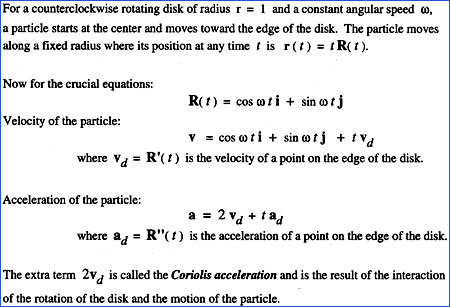
|
According to Harry F. Davis, writing in 1961, the Coriolis acceleration is "more complicated and is usually not discussed in elementary physics textbooks." He suggests a careful examination of the derivation will show the term applies "partly to the change in direction of the radial component of velocity, and partly to the fact that, as the radius changes, the transverse component of velocity changes, even if the angular velocity is constant."
Professor Davis did not have the advantage of computer animation. Tevian Dray has used the surface of the earth to illustrate this phenomenon. Moreover, modern calculus texts with a chapter on "Vector Functions" covering planetary motion may have problems on this subject.
|
References
Harry F. Davis, Introduction to Vector Analysis, Allyn and Bacon, Inc. 1961.
James Stewart, Calculus, 5th ed., THOMSON Brooks/Cole, 2003. |
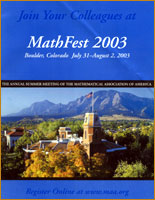 |
Tevian Dray
presented the Vector Calculus Bridge Project at MathFest 2003.
His minicourse emphasized vectors and vector calculus.
In the program he wrote, "The
key
to bridging the gap between mathematics and the physical sciences is
geometric
reasoning."
This approach was pioneered by
the
French mathematician Gaspard Gustave de Coriolis (1792 -
1843). He showed that
the laws of motion
could be used in a rotating system if an extra force, now called the
Coriolis
acceleration, is added to the equations of motion.
In 1835 Coriolis wrote on a mathematical theory of billiards. Similarly, Dray has chosen to call his investigations "earth hockey."
|
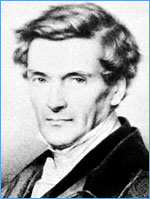 |
|